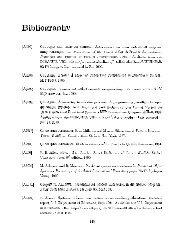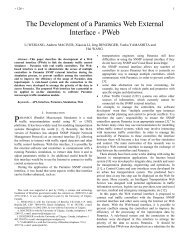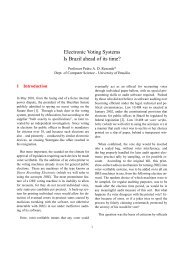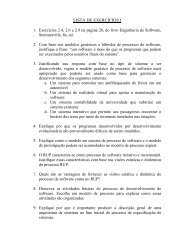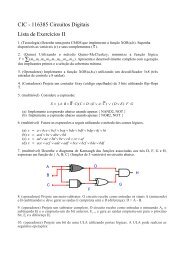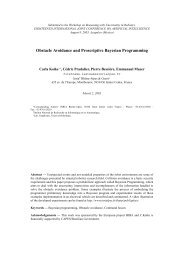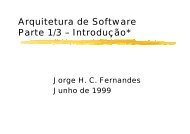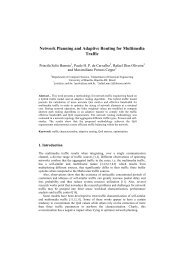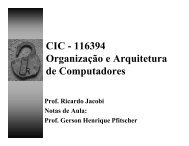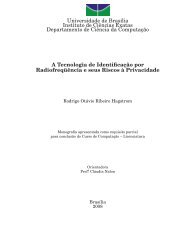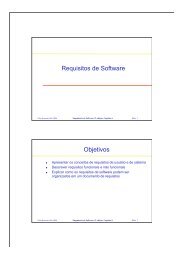FIG. 7. A token of /b/ produced by a 5-year-old girl which yielded a negativevalue of Pd difference between Pc, pressure at closure, and Pr, pressureat release.Müller and Brown 1980 were unique in proposingmethods of measuring time-varying aspects of P io duringstop closures. The results of their own and subsequent aerodynamicmodeling e.g., Westbury, 1983; Westbury andKeating, 1986 suggested further that the time course of P ioincrease during stop consonants could provide informationon aerodynamic management of voiced stops. For these reasons,the current work employed the measure, proposed byMüller and Brown as a simple metric for capturing aspects ofP io pulse shape. Yet the data obtained here, as well as closeinspection of Müller and Brown’s own data, suggest that thismeasurement method may have limitations. Specifically,some of the measures used to calculate and n yieldedunexpected values. These primarily reflected two situations:Cases where Pd pressure difference between release andclosure and angle from average to release pressure werenegative. Pressure pulse depictions like those in Fig. 2 leadone to expect both to be positive. The next paragraphs brieflydescribe how these values came about.Negative values of Pd occurred in five tokens threefrom children, two from men; four of the five were in /b/.An example from a 5 year old is given in Fig. 7. This tokenalso had a negative . In this production, intraoral pressuredecreases right before release. Although these examples areinfrequent in our database, they appear to indicate that supraglottalmovements affecting pressure contours may be initiatedrather late during the closure.Whereas negative Pd was rare, negative was morecommon, occurring in 155 tokens 15% of the data forwomen and children combined. These were found acrossage groups 36%, 39%, and 26% came from women, 10 yearolds, and 5 year olds respectively, and were about equallydistributed across consonants 53% for /p/; 47% for /b/. Tokenswith negative also accounted for 12% of the men’sdata. Negative occurs when the rise from closure to averagepressure Pa is greater than the pressure difference betweenclosure and release Pd. Such values may also haveoccurred in Müller and Brown’s 1980 data: Their plotsshow some speaker averages close to zero, with standarddeviations consistent with negative values. The occurrence ofnegative changes the interpretation of : Higher values of may result not only from convex wave forms, but alsofrom pressure contours that fall between the time of averagepressure and the time of release. To determine whether valuesof negative affected the conclusions, all statistics basedon or n were rerun without tokens whose values werenegative. The results were similar or identical to the originalones, suggesting that the occurrence of negative does notaffect the general pattern of results in this work. Further,case-by-case review of these − tokens did not show them tobe atypical in ways other than their values; that is, theyappeared to represent legitimate data points. The main observationto be made here is that Müller and Brown’s measurementmethods may yield some paradoxical values, and may reflect not only the convex/concave nature of a pressurepulse. It appears that more work is needed on how best toassess the time-varying characteristics of intraoral pressuredata.V. CONCLUSIONSAn extensive literature, using VOT as well as other measures,has indicated that stop consonant voicing is more limitedin preschool children than in adults. This has been attributedto poor aerodynamic control in the context ofanatomical growth and physiological maturation, processeswhich persist into adolescence. The current study usedMüller and Brown’s 1980 measure to assess the relationshipbetween P io characteristics and stop consonant voicingin children and adults. Unexpectedly, measures of voicingand did not differ significantly across age groups. For the5 year olds, this may reflect limited sample sizes, but it appearsthat by 10 years of age, children have learned to producevirtually adult-like voicing patterns despite immaturephysical systems. The correlational patterns between andstop consonant voicing do suggest, however, that aerodynamiccontrol of voicing in children is still subject to morevariability than in adult speakers, and that some children,particularly at 5 years but maybe also at 10 years, have notyet learned to manipulate intraoral pressure as effectively asadults.When interspeaker variability is taken into account, values for the current adult speakers seem consistent withthose of Müller and Brown 1980, although varying stimulusmaterials may have yielded some differences between thetwo studies. More interesting is that issues arose relative tothe measure itself. Paradoxical values of appear to haveoccurred in Müller and Brown’s data as well as our own.Although these difficulties do not negate the conclusions ofMüller and Brown regarding mechanisms of pressure controlin adults, they do suggest that new methods of assessingtime-varying characteristics of intraoral pressure data shouldbe devised in order to characterize the data more fully andappropriately. Future work should explore this topic further.ACKNOWLEDGMENTSSeveral students from Long Island University, BrooklynCampus and New York University contributed to recordingand data analysis for this project. In alphabetical order: GiridharAthmakuri, Jesse Farver, Linda Greenwald, Ingrid Katz,Karen Keung, Elizabeth Perlman, Simcha Pruss, and GabrielleRothman see Rothman, et al., 2002. Thanks to Elaine1086 J. Acoust. Soc. Am., Vol. 123, No. 2, February 2008 L. L. Koenig and J. C. Lucero: Voicing and intraoral pressure
Russo Hitchcock for assistance in subject recruitment andscheduling; to Linda Hunsaker for creating the stimulus pictures;to W. Einar Mencl and Scott Youmans for statisticaladvice; and to Anders Löfqvist, Katherine S. Harris, ArthurAbramson, Brad Story, and four anonymous reviewers forcomments on earlier versions of this manuscript. This workwas supported by NIH Grant No. DC-04473-03 to HaskinsLaboratories and by Conselho Nacional de DesenvolvimentoCientifico e Tecnologico-CNPq Brazil.1 In addition to convex, concave, and linear, Müller and Brown also categorizeda few tokens as bimodal double-peaked or delayed increasingslope, then a flat region, then increasing slope again. These five categorieswere further divided into tokens that had an abrupt slope change in therising phase of the curve breaking tokens versus those that did notsmooth tokens. Although the original analysis of our data included thiscategorization, rater reliability was unacceptably low for the full tencategoryanalysis, so those results are not included here. Because the currentpaper only presents data for Müller and Brown’s quantitative analysis,some details of the qualitative measurement scheme have been supressedin the main text.2 The speech of the children with negative values was not obviously remarkablein other ways; for example, it was not the case that more tokenswere discarded from these children because of production errors.3 The two consonants were combined here in order to provide the mostgeneral picture of how voicing and pressure are related. The primary articulatorydifference between /p/ and /b/, viz. vocal fold abduction, shouldlead to a faster pressure increase in /p/ i.e., higher as well as a reductionin voicing. Voicing in milliseconds is used here following the onestudy that explicitly compared closure voicing and P io trajectories Westbury,1983. Correlations between and voicing as a percentage of theclosure were qualitatively similar, but most r values were somewhat lowerand fewer values reached significance. Finally, correlations for /b/ alonealso yielded a majority of negative values 21 of 24 speakers, but only 2of 24 p values reached significance. Some reduction in statistical significanceis to be expected in both cases simply because only about half asmany data points were included in each analysis.Allen, G. D. 1985. “How the young French child avoids the pre-voicingproblem for word-initial stops,” J. Child Lang 12, 37–46.Arkebauer, H. J., Hixon, T. J., and Hardy, J. C. 1967. “Peak intraoral airpressures during speech,” J. Speech Hear. Res. 10, 196–208.Atkinson, J. E. 1978. “Correlation analysis of the physiological featurescontrolling fundamental voice frequency,” J. Acoust. Soc. Am. 63, 211–222.Barton, D., and Macken, M. A. 1980. “An instrumental analysis of thevoicing contrast in word-initial stops in the speech of four-year-oldEnglish-speaking children,” Lang Speech 23, 159–169.Bell-Berti, F. 1975. “Control of pharyngeal cavity size for English voicedand voiceless stops,” J. Acoust. Soc. Am. 57, 456–461.Bernthal, J. E., and Beukelman, D. R. 1978. “Intraoral air pressure duringthe production of /p/ and /b/ by children, youths, and adults,” J. SpeechHear. Res. 21, 361–371.Bosma, J. F. 1975. “Anatomic and physiologic development of the speechapparatus,” in The Nervous System: Human Communication and its Disorders,edited by D. B. Tower Raven, New York, Vol. 3, pp. 469–481.Brown, W. S., Jr. 1979. “Supraglottal air pressure variations associatedwith consonant productions by children,” in Current Issues in the PhoneticSciences: Proceedings of the IPS-77 Congress, edited by H. Hollien and P.Hollien Benjamins, Amsterdam, Vol. 2, pp. 935–944.Crelin, E. S. 1987. The Human Vocal Tract: Anatomy, Function, Development,and Evolution Vantage, New York.de Troyer, A., Yernault, J.-C., Englert, M., Baran, D., and Paiva, M. 1978.“Evolution of intrathoracic airway mechanics during lung growth,” J.Appl. Physiol.: Respir., Environ. Exercise Physiol. 44, 521–527.Docherty, G. 1992. The Timing of Voicing in British English ObstruentsForis, Berlin.Eguchi, S., and Hirsh, I. J. 1969. “Development of speech sounds in children,”Acta Oto-Laryngol. 57, 1–51.Fitch, W. T., and Giedd, J. 1999. “Morphology and development of thehuman vocal tract: A study using magnetic resonance imaging,” J. Acoust.Soc. Am. 106, 1511–1522.Flege, J. E. 1982. “Laryngeal timing and phonation onset in utteranceinitialEnglish stops,” J. Phonetics 10, 177–192.Flege, J. E., and Brown, W. S., Jr. 1982. “The voicing contrast betweenEnglish /p/ and /b/ as a function of stress and position-in-utterance,” J.Phonetics 10, 335–345.Gelfer, C. E., Harris, K. S., Collier, R., and Baer, T. 1983. “Is declinationactively controlled?” in Vocal Fold Physiology: Biomechanics, Acousticsand Phonatory Control, edited by I. Titze and R. Scherer Denver Centerfor the Performing Arts, Denver, pp. 113–126.Goldstein, U. 1980. “An articulatory model for the vocal tracts of growingchildren,” Doctoral dissertation, Massachusetts Institute of Technology,Cambridge.Hirano, M., Kurita, S., and Nakashima, T. 1983. “Growth, development,and aging of human vocal folds,” in Vocal Fold Physiology: ContemporaryResearch and Clinical Issues, edited by D. M. Bless and J. H. AbbsCollege-Hill, San Diego, pp. 22–43.Hoit, J. D., Hixon, T. J., Watson, P. J., and Morgan, W. J. 1990. “Speechbreathing in children and adolescents,” J. Speech Hear. Res. 33, 33–69.Ishizaka, K., and Matsudaira, M. 1972. “Theory of vocal cord vibrations,”Bull. Univ. Electro-Comm. 23, 107–136.Kahane, J. C. 1982. “Growth of the human prepubertal and pubertal larynx,”J. Speech Hear. Res. 25, 446–455.Kent, R. D., and Forner, L. L. 1980. “Speech segment durations in sentencerecitations by children and adults,” J. Phonetics 8, 157–168.Kent, R. D., and Moll, K. L. 1969. “Vocal-tract characteristics of the stopcognates,” J. Acoust. Soc. Am. 46, 1549–1555.Kewley-Port, D., and Preston, M. 1974. “Early apical stop production: Avoice onset time analysis,” J. Phonetics 2, 195–210.Kirk, R. E. 1999. Statistics: An Introduction Harcourt Brace College Publishers,Forth Worth.Lieberman, P. 1967. Intonation, Perception, and Language MIT, Cambridge,MA.Lindqvist, J. 1972. “Laryngeal articulation studied on Swedish subjects,”Quart. Stat. Prog. Rept. Sp. Transm. Lab., Royal Inst. Tech., Stockholm2–3, 10–27.Lisker, L. 1970. “Supraglottal air pressure in the production of Englishstops,” Lang Speech 13, 215–230.Lisker, L., and Abramson, A. S. 1964. “A cross-language study of voicingin initial stops: Acoustical measurements,” Word 20, 384–422.Löfqvist, A. 1975. “A study of subglottal pressure during the production ofSwedish stops,” J. Phonetics 3, 175–189.Lucero, J. C., and Koenig, L. L. 2005. “Phonation threshold pressures as afunction of laryngeal size in a two-mass model of the vocal folds,” J.Acoust. Soc. Am. 118, 2798–2801.Malécot, A. 1966. “The effectiveness of intra-oral air-pressure-pulse parametersin distinguishing between stop cognates,” Phonetica 14, 65–81.Mansell, A. L., Bryan, A. C., and Levison, H. 1977. “Relationship of lungrecoil to lung volume and maximum expiratory flow in normal children,”J. Appl. Physiol.: Respir., Environ. Exercise Physiol. 42, 817–832.McGlone, R. E., and Shipp, T. 1972. “Comparison of subglottal air pressuresassociated with /p/ and /b/,” J. Acoust. Soc. Am. 51, 664–665.Miller, C. J., and Daniloff, R. 1977. “Aerodynamics of stops in continuousspeech,” J. Phonetics 5, 351–360.Müller, E. M., and Brown, W. S. 1980. “Variations in the supraglottal airpressure waveform and their articulatory interpretation,” in Speech andLanguage: Advances in Basic Research and Practice, edited by N. LassAcademic, Madison, WI, Vol. 4, pp. 318–389.Netsell, R. 1969. “Subglottal and intraoral air pressures during the intervocaliccontrast of /t/ and /d/,” Phonetica 20, 68–73.Netsell, R., Lotz, W. K., Peters, J. E., and Schulte, L. 1994. “Developmentalpatterns of laryngeal and respiratory function for speech production,” J.Voice 8, 123–131.Ohde, R. N. 1985. “Fundamental frequency correlates of stop consonantvoicing and vowel quality in the speech of preadolescent children,” J.Acoust. Soc. Am. 78, 1554–1561.Perkell, J. S. 1969. Physiology of Speech Production: Results and Implicationsof a Quantitative Cineradiographic Study MIT, Cambridge, MA.Polgar, G., and Weng, T. R. 1979. “The functional development of therespiratory system from the period of gestation to adulthood,” Am. Rev.Respir. Dis. 120, 625–695.Preston, M. S., and Port, D. K. 1969. “Further results on the developmentof voicing in stop-consonants in young children,” Haskins Labs. StatusRpts. 19/20, 189–199.J. Acoust. Soc. Am., Vol. 123, No. 2, February 2008 L. L. Koenig and J. C. Lucero: Voicing and intraoral pressure 1087



